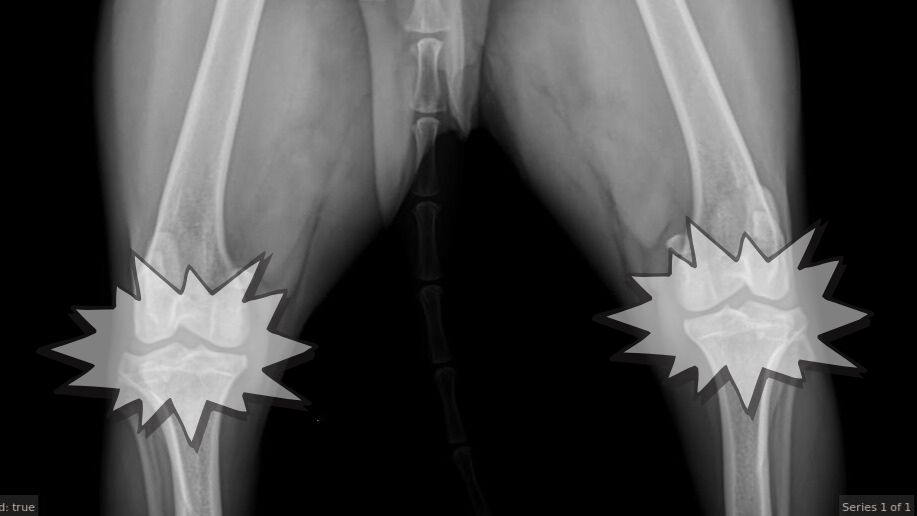Dogs, like humans, can suffer from arthritis, particularly as they age. Recognizing the early signs and understanding the causes can help prevent further discomfort for your beloved canine companion.

Speaking of prevention, it is always best to prevent arthritis rather than treat it. Biohacking for Dogs focuses on best health practices for the life of the dog and trying to avoid old age diseases such as arthritis, but I know several dog owners do not find us until after their pup has a problem, thus this article is for those of you who have a pup suffering from this joint disease.
Common symptoms include limping, stiffness, difficulty in getting up or down, reluctance to jump or climb stairs, and noticeable changes in behavior like irritability or decreased activity levels. These signs often become more pronounced after exercise, during cold weather, or in some during hot and humid weather.
There are different types of arthritis that can affect dogs. Osteoarthritis, known as degenerative joint disease, is the most common. It usually results from wear and tear on the joints. Rheumatoid arthritis, an autoimmune condition, can also occur but is less common.
Several factors contribute to the development of arthritis in dogs. Breed plays a significant role, with larger breeds like German Shepherds, Labradors, and Golden Retrievers being more susceptible. Age is another major factor; as dogs get older, their joints naturally wear down. Weight can exacerbate joint problems as well. Overweight dogs put additional stress on their joints, leading to quicker degeneration. Injuries or trauma to joints can also trigger arthritis, even in younger dogs.
Early detection is crucial. If you notice any of these symptoms in your dog, it’s best to consult with a veterinarian as soon as possible. Early intervention can help manage the condition and improve your dog’s quality of life. Keeping an eye on your dog’s behavior and mobility can make a big difference.
Veterinary Diagnosis and Assessment
Diagnosing arthritis in dogs involves a thorough examination by a veterinarian. They typically start with a detailed medical history, asking questions about your dog’s symptoms, activity levels, and any noticeable changes in behavior or mobility.
A physical examination follows, where the vet checks for joint pain, stiffness, and swelling. This hands-on approach helps identify areas affected by arthritis and gauge the severity.

Diagnostic tools and tests play a crucial role. Radiographs (x-rays) are commonly used to visualize joint changes and determine the extent of the condition. MRI scans might be required for a more detailed view of the joints, although not commonly used for arthritis, but rather other causes of lameness not visually seen on radiography. Joint fluid analysis can also be performed to rule out other conditions and confirm the presence of arthritis, specifically if it is autoimmune based, such as in rheumatoid arthritis.
It’s important for pet owners to play an active role in the diagnostic process. Providing accurate information about your dog’s behavior, diet, and daily activities can help the vet make an informed diagnosis. Keeping a journal of your dog’s symptoms and changes in routine can be particularly useful.
Understanding the severity of your dog’s arthritis is critical for choosing the best treatment plan. Vets often use a grading system to classify the condition, ranging from mild to severe. This helps in tailoring treatments to manage pain and improve mobility effectively.
Conventional Treatments for Canine Arthritis
Once your dog is diagnosed with arthritis, the next step is finding effective treatment options. Conventional treatments offer a range of solutions to manage pain and improve your dog’s quality of life.
Medications are often the first line of offense. Nonsteroidal anti-inflammatory drugs (NSAIDs) are commonly prescribed to reduce inflammation and relieve pain. Glucocorticoids (corticosteroids), another type of anti-inflammatory medication, might be recommended for severe cases or autoimmune cases. It’s important to follow your vet’s dosage instructions carefully, as these medications can have side effects.
Physical therapy and rehabilitation can benefit dogs with arthritis. Techniques like hydrotherapy, where dogs exercise in water, help reduce the stress on joints while improving strength and mobility. Regular physical activity tailored to your dog’s capabilities is crucial. Your vet or a certified pet physical therapist can guide you through suitable exercises and routines.
In some cases, surgery becomes necessary. Procedures like joint replacement or arthroscopy can provide significant relief, especially for dogs not responding well to medications or physical therapy. Discuss the risks and benefits with your vet to make an informed decision.
Conventional treatments come with their own set of pros and cons. While medications and surgeries can be highly effective, they also carry potential risks and side effects. It’s essential to stay informed and work closely with your veterinarian to monitor your dog’s progress and adjust treatments as needed.
Alternative and Holistic Approaches to Pain Management
Exploring alternative and holistic approaches can complement conventional treatments and provide added relief for dogs dealing with arthritis.
Acupuncture has excellent results for pain management. Acupuncture involves inserting thin needles into specific points on the body to stimulate healing and reduce pain. From the medical viewpoint it is stimulating the nervous system to create the body changes. In Traditional Chinese Veterinary Medicine (TCVM) the needles are opening pathways in lines of acupuncture points called meridicans to unblock the energy flow, called Qi. The unblocking of the flow causes the body changes.
Chiropractic rebalances the body and nervous system to reduce pain and relax muscles. It uses low-amplitude thrusts on joints that are not moving effectively or efficiently to reset them neurologically. This changes the neuroreceptors in the area and alters the signaling of the nervous system. This changes how the body moves, which is critical for dogs with arthritis who are moving incorrectly due to their pain. Helping the body move more biomechanically correctly helps overall health and well-being.
Laser therapy and Pulsed Electromagnetic Field (PEMF) devices can significantly reduce pain and inflammation. Laser therapy uses specific wavelengths of light to penetrate tissues, reducing inflammation and promoting healing. Where as PEMF uses a magnetic field at a specific frequency to do the same. Laser is a more focused treatment, whereas PEMF is a broader treatment. Current research has shown that although both work quite well for reducing pain and inflammation, PEMF does better for chronic problems, such as arthritis.
Nutritional supplements like glucosamine and chondroitin are often recommended for joint support. These supplements can help rebuild cartilage and improve joint function, but currently, there are significant problems with the quality and effectiveness of many of these supplements. So much so, that the AVMA is not promoting their use for the treatment of arthritis.
Natural remedies, such as turmeric, boswellia, and omega-3 fatty acids, can also aid in reducing inflammation and pain. These natural options can be easily incorporated into your dog’s diet. We have talked at length about fish oil in articles here at Biohacking for Dogs. One other natural remedy is Green Lipped Mussel or Perna Mussel; not only does it have more bioavailable glucosamine, chondroitin, and Omega 3s, but it also has other components that help reduce inflammation.
Hydrotherapy, similar to physical therapy, involves water-based exercises that help reduce joint stress while enhancing mobility. Many dogs find this method comfortable and enjoyable, making it an excellent addition to their treatment plan.
Massaging techniques can improve blood circulation and relieve muscle tension around arthritic joints. Gentle, regular massages can provide comfort and improve your dog’s overall well-being.
Creating a Comfortable Home Environment
Making your home more accommodating for a dog with arthritis can significantly enhance their comfort and mobility. Simple modifications can make a big difference.
Start with the right bedding. Orthopedic dog beds are specially designed to provide support and relieve pressure on sore joints. Make sure the bed is easily accessible, avoiding elevated or hard-to-reach spots.
Floor surfaces in your home should also be considered. Slippery floors can be dangerous for dogs with arthritis. Placing rugs or non-slip mats can help prevent falls. Using devices such as ToeGrips can significantly help with slick floors.
Pay attention to furniture. Ramps and pet stairs can make it easier for your dog to reach their favorite spots without jumping, which can strain their joints. Ensure that food and water bowls are at a comfortable height to reduce neck and back strain.
Weight management and a healthy diet play an essential role in managing arthritis. Keeping your dog at an ideal weight reduces stress on their joints. Have your dog on a fresh food-based balanced diet plan that meets your dog’s nutritional needs while managing their weight.
Regular monitoring is key to managing arthritis effectively. Keep an eye on your dog’s activity levels and any changes in their behavior. Regular check-ins with your veterinarian ensure that treatments are working and allow for adjustments as needed.
Specific plan for canine arthritis
Typical plan for a dog with mild to moderate osteoarthritis includes inflammation management, joint support, and muscle fitness.
Inflammation management – fish oil and natural anti-inflammatories
and using a Pulsed Electromagnetic Field (PEMF) device such as a Pets PEMF pad that you can purchase one here -> Pets PEMF
Joint support – Green Lipped Mussel and Collagen
Muscle Fitness – an exercise program, especially core muscle development

Managing arthritis in dogs requires a multifaceted approach that combines early detection, veterinary diagnosis, conventional treatments, and alternative therapies. At Biohacking for Dogs, our goal is to support dog owners in preventing and managing this debilitating condition through holistic and scientifically-backed methods. By staying vigilant for early signs of arthritis and working closely with your veterinarian, you can significantly improve your dog’s quality of life. Remember, the right combination of treatments and home modifications can make a world of difference for your dog. Let’s ensure that every step they take is as comfortable and pain-free as possible, giving them the happy, active life they deserve.